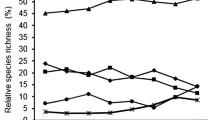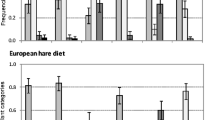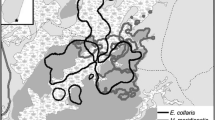Summary
Food partitioning among lemurs was studied in relation to food patch size and plant chemistry in the eastern rainforest and a western deciduous forest of Madagascar. Patch size (i.e. crown diameter of food trees) is significantly correlated with group body weight of different lemur species. But intraspecific variability is high and prevents effective species separation. Chemical analyses of more than 400 plant parts eaten by seven different lemur species revealed major differences in their food choice with respect to protein concentrations, condensed tannins and alkaloids. Among the leaf eating lemurs discriminant analysis segregates three groups à two species based on chemical characteristics of their food. Whereas differences in food chemistry are pronounced between groups they are lacking between the two species within each group. The two species of each group avoid interference competition by different activity rhythms. Actual competition for slowly renewable resources such as leaves and fruit, however, can not be reduced by different activities. Here interspecific differences in gross categories of food, food species composition and different habitat utilization due to other constraints may contribute to the possible coexistence of species. Thus interspecific differences in food selection in relation to primary and secondary plant chemicals is an integrated part of the mechanisms allowing several primate species to coexist in sympatry.
Similar content being viewed by others
References
Bourlière F (1985) Primate communities: Their structure and role in tropical ecosystems. Int J Primatol 6:1–26
Bradford M (1976) A rapid and sensitive method for the quantification of microgram quantities of protein utilizing the principle of protein-dye-binding. Anal Biochem 72:248–254
Brattsten LB (1979) Biochemical defense mechanisms in herbivores against plant allelochemicals. In: Rosenthal GA, Janzen DH (eds) Herbivores. Academic Press, London New York, pp 200–270
Chapman RF, Blaney WM (1979) How animals perceive secondary compounds. In: Rosenthal GA, Janzen DH (eds) Herbivores. Academic Press, London New York, pp 161–168
Charles-Dominique P, Cooper HM, Hladik A, Hladik CM, Pages E, Pariente GF, Petter-Rousseaux A, Petter JJ, Schilling A (1980) Nocturnal Malagasy primates. Academic Press, New York
Chivers DJ, Hladik CM (1980) Morphology of the gastrointestinal tract in primates: comparison with other mammals in relation to diet. J Morphology 166:337–386
Clutton-Brock TH, Harvey PH (1977) Primate ecology and social organisation. J Zool, London 183:1–39
Cody ML (1974) Competition and the structure of bird communities. Princeton Univ Press, Princeton
Cromwell BT (1955) The alkaloids. In: Paech K, Tracy MV (eds) Modern methods of plant analysis. 4, pp 367–374
Deichsel G, Trampisch HJ (1985) Biometry: Clusteranalyse und Diskriminanzanalyse. G Fischer, Stuttgart
Dewar RE (1984) Recent extinctions in Madagascar: The loss of the subfossil fauna. In: Martin PS, Klein RG (eds) Quaternary Extinctions. Univ Arizona Press, Phoenix, pp 574–593
Ehrlich PR, Raven PH (1964) Butterflies and plants: a study in coevolution. Evolution 18:586–608
Eze JMO, Dumbroff EB (1982) A comparison of the Bradford and Lowry methods for the analysis of protein in chlorophyllous tissue. Can J Bot 60:1046–1049
Ganzhorn JU (1987a) Soil consumption in two groups of semi-free ranging lemurs (Lemur catta and Lemur fulvus). Ethology 74:146–154
Ganzhorn JU (1987b) A possible role of plantations for primate conservation in Madagascar. Am J Primatol 12:205–215
Ganzhorn JU (1988) Primate species separation in relation to secondary plant chemicals. In: Rumpler Y, Preuschoft HG (eds) Speciation systematics and conservation of Prosimians (in press)
Ganzhorn JU, Rabesoa J (1986) The aye-aye (Daubentonia madagascariensis) found in the eastern rainforest of Madagascar. Folia Primatol 46:125–126
Gause GF (1969) The struggle for existence. Hafner Publ Comp, New York
Glander KE (1982) The impact of plant secondary compounds on primate feeding behavior. Yearbook Phys Anthropol 25:1–18
Glaser D (1986) Geschmacksforschung bei Primaten. Vierteljahresschrift der Naturforschenden Gesellschaft in Zürich 131:92–110
Glaser D, Hobi G (1985) Taste responses in primates to citirc and acetic acid. Int J Primatol 6:395–398
Goering HK, van Soest PJ (1970) Forage fiber analysis. Agric Handb No 379. Agricultural Research Service. US Department of Agriculture
Harrington JE (1975) Field observations of social behavior of Lemur fulvus fulvus E. Geoffroy 1812. In: Tattersall I, Sussman RW (eds) Lemur biology. Plenum Press, New York, pp 259–279
Hladik CM (1977) A comparative study of the feeding strategies of two sympatric species of leaf monkeys: Presbytis senex and P. entellus. In: Clutton-Brock TH (ed) Primate ecology: studies of feeding and ranging behaviour in lemurs monkeys and apes. Acad Press, London, pp 324–353
Hladik CM (1979) Diet and ecology of Prosimians. In: Doyle GA, Martin RD (eds) The study of Prosimian behaviour. Academic Press, New York, pp 307–357
Hladik CM, Hladik A, Bousset J, Valdebouze P, Viroben G, Delort-Laval J (1971) Le régime alimentaire des primates de l'Ile de Barro-Colorado (Panama). Résultats des analyses quantitatives. Folia Primatol 16:85–122
Hutchinson GE (1957) Concluding remarks. Cold Spring Harbor Symp Quant Biol 22:415–427
Janzen DH, Waterman PG (1984) A seasonal census of phenolic, fiber and alkaloids in foliage of forest trees in Costa Rica: Some factors influencing their distribution and relation to host selection by Sphingidae and Saturniidae. Biol J Linn Soc 21:439–454
Kates M (1972) Techniques of lipidology. In: Work TS, Work E (eds) Laboratory techniques in biochemistry and molecular biology. vol 3. North-Holland Publ Comp Amsterdam, pp 267–610
Martin JS, Martin MM (1982) Tannin assays in ecological studies: lack of correlation between phenolics, proanthocyanidins and protein-precipitating constitutents of mature foliage of six oak species. Oecologia (Berlin) 54:205–211
Martin RD (1972) Behaviour and ecology of nocturnal Prosimians. Z Tierpsychol Beiheft 9:43–89
McNaughton SJ, Georgiadis NJ (1986) Ecology of African gazing and browsing mammals. Ann Rev Ecol Syst 17:39–65
Mittermeier RA, Oates JF (1985) Primate diversity: The world's top countries. Prim Conserv 5:41–48
Mole S, Waterman PG (1987a) A critical analysis of techniques for measuring tannins in ecological studies. I. Techniques for chemically defining tannins. Oecologia (Berlin) 72:137–147
Mole S, Waterman PG (1987b) A critical analysis of techniques for measuring tannins in ecological studies. II. Techniques for biochemically defining tannins. Oecologia (Berlin) 72:148–156
Mühlenberg M (1976) Freilandökologie. Quelle und Meyer, Heidelberg
Oates JF, Swain T, Zantovska J (1977) Secondary compounds and food selection by Colobus monkeys. Biochem Syst Ecol 5:317–321
Petter JJ, Peyrieras A (1970) Nouvelle contribution à l'étude d'un lémurien malgache, le aye-aye (Daubentonia madagascariensis). Mammalia 34:167–193
Pollock JI (1975a) The social behaviour and ecology of Indri indri. Unpubl Ph D thesis. London Univ
Pollock JI (1975b) Field observation on Indri indri: A preliminary Report. In: Tattersall I, Sussman RW (eds) Lemur Biology. Plenum Press, New York, pp 287–311
Pollock JI (1979) Spatial distribution and ranging behavior in Lemurs. In: Doyle GA, Martin RD (eds) Academic Press, New York, pp 359–409
Pollock JI (1986) A note on the ecology and behavior of Hapalemur griseus. Prim Conserv 7:97–101
Pollock JI, Constable ID, Mittermeier RA, Ratsirarson J, Simons H (1985) A note on the diet and feeding behavior of the Aye-aye, Daubentonia madagascariensis. Int J Primatol 6:435–447
Rhoades DF (1985) Offensive-defensive interactions between herbivores and plants: their relevance in herbivore poluation dynamics and ecological theory. Am Nat 125:205–238
Richard AF (1978) Behavioral variation. Bucknell Univ Press
Richard AF (1985) Primates in nature. Freeman and Co, New York
Robbins CT (1983) Wildlife feeding and nutrition. Academic Press, New York
Roosmalen MGM van (1984) Subcategorizing food in primates. In: Chivers DJ, Wood BA, Bilsborough A (eds) Food acquisition and processing in primates. Plenum Press, New York, pp 167–175
SAS/STAT (1985) Guide for Personal Computers. Cary
Schaik CP van, Hooff JARAM van (1983) On the ultimate causes of primate social systems. Behaviour 85:91–117
Seligson D, Szalay FS (1978) Relationship between natural selection and dental morphology: tooth function and diet in Lepilemur and Hapalemur. In: Butler PM, Joysey KA (eds) Development, Function and Evolution of Teeth. Academic Press, London, pp 289–307
Siegel S (1956) Nonparametric Statistics. McGraw-Hill Kogahusha Ltd, Tokyo
Smuts BB, Cheney DL, Seyfarth RM, Wrangham RW, Struhsaker TT (1986) Primate Societies. Univ Chicago Press, Chicago
Sourd C, Gautier-Hion A (1986) Fruit selection by a forest guenon. J Anim Ecol 55:235–244
Tattersall I (1982) The primates of Madagascar. Columbia Univ Press, New York
Terborgh J (1983) Five New World Primates. Princeton Univ Press, New Jersey
Terborgh J (1986) Keystone plant resources in the tropical forest. In: Soulé ME (ed) Conservation Biology. Sinauer, Sunderland, pp 330–344
Terborgh J, Janson CH (1986) The sociecology of primate groups. Ann Rev Ecol Syst 17:111–136
Waterman PG (1984) Food aquisition and processing as a function of plant chemistry. In: Chivers DJ, Wood BA, Bilsborough A (eds) Food acquisition and processing in primates. Plenum Press, New York, pp 177–211
Wisdom CS, Gonzales-Coloma A, Rundel PW (1987) Ecological tannin assays. Oecologia (Berlin) 72:395–401
Wrangham RW (1980) An ecological model of female-bonded primate groups. Behaviour 75:262–300
Wright PC (1985) Costs and benefits of nocturnality of Aotus trivirgatus (the night-monkey). Ph D thesis. City Univ New York
Wright PC (1986) Ecological correlates of monogamy in Aotus and Callicebus. In: Lee PC, Else J (eds) Primate ecology and conservation. Cambridge Univ Press, pp 159–167
Author information
Authors and Affiliations
Rights and permissions
About this article
Cite this article
Ganzhorn, J.U. Food partitioning among Malagasy primates. Oecologia 75, 436–450 (1988). https://doi.org/10.1007/BF00376949
Received:
Issue Date:
DOI: https://doi.org/10.1007/BF00376949




